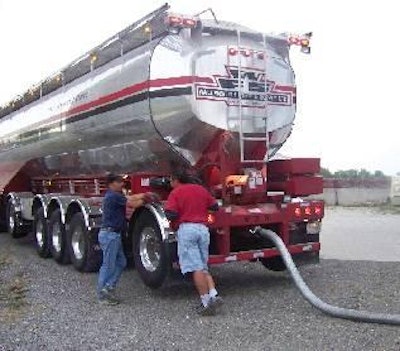
Rapidly rising fuel prices are taking a huge bite out of profits for nearly all businesses, feed manufacturing included. Any efficiencies that can be squeezed out of energy usage could mean precious savings for operational budgets.
Transportation companies allied with the feed industry have been putting much emphasis on the development of energy-saving options for feed manufacturers. One of the areas most often centered on is efficiency of loading and unloading. The less time spent on any given load, the lower the energy costs.
Reducing unload time
For example, Hensley has developed what they call their Super Auger, which the company claims will unload at the rate of between 6,000 and 7,000 lbs. per minute. The company says the Super Auger can unload 24 tons in under eight minutes at 1,200 RPMs, while the same amount of feed might take up to 30 minutes to unload otherwise. Their equipment offerings include models with both front and rear unload to provide mills with the option that will prove most efficient for a particular set up. The company says their front unload models not only offer greater visibility to the operator, but are easier to position, cutting the time required to deliver a load of feed which can equate into fuel savings.
Sudenga Industries has also been putting emphasis into the development of improving energy efficiency through development of equipment with fast and efficient unloading.
How can transportation efficiencies such as these best be realized? Feed Management recently sat down with Terry Medemblik, sales and marketing manager, Walinga Inc. to talk about improving energy efficiencies in feed transportation.
FM: Energy costs have continued to grow dramatically and greatly impact feed mill operational expenses. What are the top three transportation efficiencies feed manufacturers should address in order to improve their energy efficiency?
Medemblik: Lighter tractor trailer combinations, tighter load/delivery schedules/programs, and good maintenance programs.
FM: Can transportation equipment choices have an impact on transport efficiencies? If so, how is this return on investment realized?
Medemblik: Most definitely! Buying lighter equipment, or more fuel efficient equipment allows more feed to be hauled with lower fuel consumption. One thing that the purchaser needs to be aware of and can be difficult at times, is pushing the weight and fuel envelope too far, subsequently ending up with equipment that has too many issues with respect to service and maintenance thereby causing the whole program to go the opposite direction it was intended for.
For example, say the purchaser tries to save on weight, orders a unit that is built too light, where the manufacturer has compromised structural integrity in favor of weight, or used sub standard or under-spec'd components in order to get the overall weight down on the unit. Such a unit would spend more time in service than is typical, causing the owner to spend more money maintaining the equipment than what he intended to save hauling more feed per load.
So, in a sense, there is a fine line here that manufacturers, and purchasers, need to be aware of in order to see that return on investments. The same issue holds true when looking at the power unit or the tractor. An under-powered tractor will in turn end up costing more than the properly spec'd tractor for a whole lot of other reasons. It is important that the purchaser look at every aspect of handling the feed, not just the bottom line of what his upfront cost is on this particular issue. Savings in dollars upfront do not necessarily translate into savings five years down the road.
FM: What are some of the new innovations in transport equipment that can improve transportation efficiencies for feed manufacturers?
Medemblik: Hydraulic oil coolers, high efficiency hydraulic components, light weight structural extrusions, light weight tire/rim combinations and better unloading components (tighter auger/trough tolerances). These are a few of the things that come readily to mind.
FM: The rising cost of corn and other grains has put a spotlight on alternative ingredients, including distillers grains. Are there difficulties in transporting some of these ingredients and if so, are there equipment choices or transport options that can minimize difficulties in dealing with some of these alternative ingredients and reduce inefficiencies?
Medemblik: For the most part, I think that these commodities flow out without a great deal of difficulty. There are some ingredients that need to have a "wide open throat", and for this there are optional gates that can be used to give a good clean out.
The other issue is, "pounds per cubic foot:" what does the commodity weigh? With lighter commodities you need more cubic capacity. The irony of these two points is, the options that are there add weight to the unit, and so, in a sense, bring the purchaser back to square one.
FM: What role does transport have in feed hygiene and safety? How do transport choices affect the ability of a manufacturer to produce safe feed?
Medemblik: Feed transport is basically the last step/stage before the customer gets the product, so, yes, there is an important role to play here. All too often, the transport portion is looked on as a negative towards the feed company. That it is, in a sense, a necessary evil, when in fact it is the last portion of control that they have. After all, the feed transport driver is really the salesman for the feed company. He is usually the one the farm operator/manager will come out to and discuss his issues, his likes and dislikes he has with the company he is getting the feed from.
So, first off, clean units, inside and out! A clean unit driving up the customer's driveway gives the customer the first impression that what the salesman sold him is in fact what he will be getting, quality feed. Quality feed also means that the feed manufacturer has done everything within his control to ensure "safe feed." It tells the customer that they care about what they are doing. A clean unit inside means minimal chance of carry over or transfer, that you don't have to worry about what was in the bin in the first place. A clean unit inside means that the driver takes time to "dry clean" the inside of his unit to prepare for the next load. Cleaning the unit inside and out will also help to cut down on maintenance issues.
If the driver is going to this extent, he will also notice any potential problems with the unit before they become serious issues, like worn hydraulic hoses or for that matter, structural cracks that may cause leaking from one compartment to another. Well-maintained, up-to-date equipment, though at first glance appear to be costly, will in the long run prove to be more cost effective than some care to recognize. Equipment with tight tolerance augers, smooth transitions, efficient hydraulics, heavy duty components and ergonomically designed will always help deliver "quality safe feed."
FM: Are there energy alternatives that will affect feed and ingredient transport?
Medemblik: Not to be pessimistic about this issue, but, I don't see too much out there at this point. Manufacturers (truck and trailer) are trying their level best to produce lighter and lighter units without incurring too much more cost to the end user, and without jeopardizing the structural integrity of the unit. The government, however, has been, it seems, doing their level best to hamper the ability of the "hauler" to make steps forward, for example, look at the new diesel emissions issue, the cost incurred and the efficiency lost, and this of course is all done under the guise of global warming. Or for that matter, limiting the amount of hours of operation.
And then the inconsistency in how much weight can be carried in one state versus the next. If the state governments could get together and allow more weight per axle, larger units could be manufactured allowing more feed to be hauled per load making the operation that much more efficient.
.jpg?auto=format%2Ccompress&crop=faces&fit=crop&h=48&q=70&w=48)















